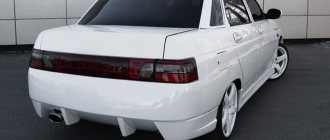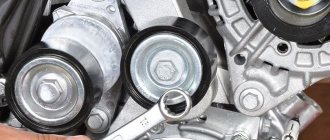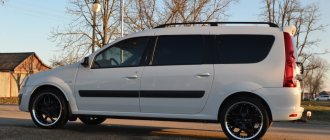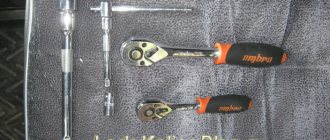Interesting modifications
The former head of AVTOVAZ, Bo Andersson, caught the fashion for pseudo-crossovers and gave instructions to quickly prepare new products. As a result, the “urban” LADA 4x4 Urban, Cross versions of Kalina and Largus were immediately born. The latter received an increase in ground clearance from 145 to 170 mm, a comfortable body kit made of unpainted plastic and unusual interior decoration. As a passenger car, the Largus looks ugly, but the “off-road” decor has noticeably improved it. Why were there so many people willing to pay extra for it? Buyers also liked the opportunity to get a car with a fiery orange interior.
Review of the new model
The current version of the Russian small-class station wagon continues to be slightly redesigned and adapted for the Russian market by the subcompact Dacia Logan MCV of the first generation (2006), which received not only a classic 5-seater version of the cabin, but also a seven-seater with a third row of seats, and an option in the form of a two-seater cargo van.
Current dimensions of the Lada Largus 2022 model year:
- length – 4470 mm;
- width – 1750 mm;
- height – 1670 mm;
- wheelbase – 2905 mm;
- ground clearance - 180 mm.
Refinement of Logan's suspension, carried out as part of the car's adaptation to Russian conditions, led to the fact that the Lada Largus 2022 received reinforced arms at the front, as well as stiffer shock absorbers and springs at the rear.
Exterior
The Lada Largus facelift for the 2022 model year, dated 2019, included an update to the radiator grille, which received a larger grille. The same logos can now be found on the steering wheel and wheel caps, but the LADA inscription now appears on the luggage compartment doors.
In addition, in the passenger version, the central pillars began to be painted black (only in the Luxury configuration). As for the Lada Largus 2022 model year, it will undergo a deeper renovation, which is expected to give the model a signature X-face.
Salon
The interior of the Lada Largus 2022 has not undergone any changes, except for the seat trim material: the developers proposed a new, more practical and wear-resistant fabric.
The luggage compartment in the passenger version, as before, can be increased by folding the second row seats and removing the third row seats (if equipped). In this case, the volume of cargo space will reach 2.5 cubic meters.
Technical stuffing
Today, the Lada Largus 2022 engine line includes two 1.6-liter gasoline engines: an 87-horsepower engine, which was installed on the first production versions of the model; and a 16-valve unit with a capacity of 106 hp. s., in 2022 received by the station wagon from Vesta.
Both power plants are coupled to a manual transmission. In 2022, AvtoVAZ promises to give the Lada Largus a five-speed AMT robot, which will complement the new 1.8-liter engine (122 hp)
Seven-seater saloon
The third row of seats in the Lada is in no way symbolic. Not only children, but also adult passengers can easily endure a long journey in the gallery. Largus is truly capable of taking seven people on board and delivering them in comfort. At the rear there are not only real seats and seat belts, but also attributes of additional comfort - cup holders and opening windows. So, if you need a car with the capacity of a minivan at a reasonable cost, there are no alternatives to Largus.
Cross
The smallest trunk size is in the Largus minivan, designed for 7 seats. The Largus Cross trunk reaches a volume of 200 liters. The manufacturer helped car owners by allowing them to increase the volume of the luggage compartment in liters to 1600–1800, for which two rows of seats should be removed.
The seven-seater version (minivan) has the most “modest” luggage compartment. But the manufacturer met his loyal customer halfway and endowed this modification with a simple secret: it is also possible to increase the luggage space to the same 1600–1800 liters by performing an identical operation to dismantle the stern seats. To do this, you will need to remove two planting rows.
Of course, neither a station wagon nor a minivan are designed to transport large loads, but if necessary, they will cope with this task perfectly.
Capacity
The station wagon, built on the basis of the first-generation Renault Logan, formally belongs to the B-class. But you can't tell by the dimensions. Some people also consider the Lada Vesta SW to be an overgrowth of sector B, while the Largus is 60 mm longer than the Vesta and by as much as 270 mm in wheelbase! It’s clear now how, with more than enough space in the second row of seats in the car, there was also room for a trunk of record volume. With a five-seat cabin configuration, it holds 560 liters, with a two-seat configuration - 2350 liters.
Even when there are seven people in the cabin, there is 135 liters left for their luggage. Not significant, but still a very respectable indicator. Moreover, Largus is not limited to an ordinary trunk. Thanks to the high ceiling above the second row of seats, the designers added a capacious shelf. She is also ready to accept some things. Let's not forget that the package includes roof rails. This means that the cargo can also be placed on the top trunk.
Specifications
Manufactured Lada Largus cars are equipped with two types of engines - 8 and 16 valves. Even in the basic configuration, the car is equipped with an airbag, a single integrated key that not only turns on the ignition, but also controls the doors and trunk lid, which is certainly convenient for a potential buyer. The engines comply with exhaust gas standards in accordance with Euro 4.
If the driver wants to increase the number of seats to seven, the rear row folds out, but in this case the trunk volume is reduced to 135 liters. Meanwhile, the van will have a trunk volume of 2540 liters.
The dimensions of the Lada Largus are as follows:
- the length is 4.47 meters, and this applies to both configuration options - van and station wagon;
- the width for both options will be 1.75 meters;
- the base at full and curb weight is 2.9 and 2.905 meters, respectively;
- The front track is 1469 millimeters (for the van - 1468 millimeters), the rear track in both cases is 1466 millimeters.
The curb weight of the Lada Largus without a driver and luggage, depending on the type, ranges from 1186 to 1294 kilograms, the payload is from 515 to 555 kilograms, for a van - 800 kilograms.
The manufacturer has announced the following color options for this car model. The passenger station wagon can be painted in colors such as metallic (Basalt Gray, Diplomat, Phoenix Platinum, Cashmere, Centaur and Venus), as well as glacial. When releasing batches of taxis, a yellow color is possible. The vans, in addition to glacial and several metallic options, are also available in sea and ruby colors.
To summarize, it can be noted that the Lada Largus model has sufficient reliability for a Russian-made car. In addition, it has a number of obvious advantages related to the ability to vary the number of passenger seats and trunk dimensions
It is also important to remember that the Lada Largus meets the latest requirements for environmental friendliness of exhaust gases, which over time becomes increasingly important when customers choose a model
pros and one big minus of Lada Largus
A phenomenal situation has developed on the Russian market. Most families can afford one car (in the best case scenario!). A station wagon would be perfect for them, but they don’t actually offer it. The only exception is LADA, but immediately with 3 models: Kalina, Largus and Vesta SW. The first one is frankly small, the second one costs a lot and is only gaining momentum in the market. But Largus has been earning a reputation since 2012. The lack of restyling (we expect it at the end of August) does not prevent the model from taking eighth place in sales statistics. Moreover, since the beginning of the year, demand for the car has increased by more than 70%! There are several components of success.
Reliability
The myth that a foreign car cannot be adapted to harsh Russian conditions better than eternal Russian cars was dispelled first by the Renault Logan, and then by its derivative LADA Largus. This car is truly very reliable and durable. Examples of operation in taxis and the commercial sector are the clearest confirmation of this. B0 platform units are undemanding, their design has been tested for years.
Replacing French engines with VAZ ones only added advantages to the model. They turned out to be no worse in terms of resource, but at the same time stronger, more “instant” and more economical. In addition, an increase in the percentage of localization helped to curb price increases.
Editorial Largus, working in ZR since 2012, was no exception to the rule. Over more than 120,000 km of mileage, it required minor unscheduled interventions, and they turned out to be uncritical and non-disastrous.
Asceticism
The main and most trivial shortcoming of Largus is his deliberate asceticism. The interior has not changed a bit since the first generation Renault Logan. The list of options contains only the required minimum, although now more buyers want to add some extras to it, such as additional heating, advanced multimedia, and electric assistants. Largus is only able to offer heated front seats, a single-din radio, ABS and rear parking sensors. There are only two airbags, the air conditioning is manually controlled.
From the outside, LADA Largus looks more like a slightly improved truck than a civilian passenger car. The situation is partly helped by the body kit of the Cross version. The long-promised automatic transmission also never appeared, as did the 1.8 engine. Commercial versions have no use for them, but many people buy Largus as a home station wagon and drive it to work every day. There are also a lot of mistakes in terms of ergonomics. If AVTOVAZ corrected at least some of these problems, the popularity of the car would immediately increase. Let's see what the future restyling will bring to Largus.
By the way, Largus also works in the ZR editorial office.
You can use it, as well as any other editorial car in our
ZR Park
.
How to remove the 3rd row of Largus seats
There are many car models that have a 3rd row of seats (for example, Suzuki GV XL7, LADA-Largus, etc.). These seats can usually be removed, or installed if they did not exist. And if we talk about minivans, then many in general have transformable interiors, quick-release seats, swivel, on skids. You can quickly remove and install seats of 2-3 rows. You can throw only the rear one, which creates a lot of free space in the center of the cabin. You can “customize” it to suit your tasks. For example, throw only one seat in the 2nd row, and use the rest of the space for transporting, for example, seedlings or bales of mineral wool. Etc.
And oh so with the legality of it all. Here is a LADA- Largus (or a similar one) from the factory with a 3rd row of seats. And the owner took and removed this 3rd row and made a large trunk in the back. What will happen during an inspection by traffic police officers in the Russian Federation? Wouldn't this be a violation of operation and the like? And in Belarus, Ukraine, Finland?
oh, the following question may come to mind.
quote: Originally posted by Serrrgey:What will happen during an inspection by traffic police officers in the Russian Federation?
quote: Originally posted by Serrrgey:Wouldn't this be a violation of operation and the like?
quote: Originally posted by Serrrgey: These seats can usually be removed, or installed if they didn't exist. And if we talk about minivans, then many in general have transformable interiors, quick-release seats, swivel, on skids. You can quickly remove and install seats of 2-3 rows.
quote: Originally posted by Serrrgey: Oh, so with the legality of all this. Here is a LADA- Largus (or a similar one) from the factory with a 3rd row of seats. And the owner took and removed this 3rd row and made a large trunk in the back. What will happen during an inspection by traffic police officers in the Russian Federation? Wouldn't this be a violation of operation and the like? And in Belarus, Ukraine, Finland?
READ How to clean car seats yourself
If I removed a row of seats, in Russia, Belarus and Ukraine everything is legal, I don’t know about bullshit, they’re still tolerant. I have a row removed myself, I drive normally. The traffic cops don't care.
quote: Originally posted by Uncle Wow: if you screw the seats in a cargo van yourself.
quote: there is an exact list of defects with which operation is prohibited
This is not a malfunction. Refurbishment is expected here.
quote: Originally posted by Serrrgey: Refurbishment is expected here.
quote: Originally posted by cccb: If you screw it according to the requirements, it won’t work.
quote: Originally posted by cccb: If you screw it according to the requirements, it won’t work.
quote: Originally posted by Serrrgey: Refurbishment is expected here.
quote: Originally posted by Uncle Uh: I'm talking about the “African” version.
quote: Originally posted by RSL: The requirements for how the seat should be screwed in can be the seat belts, but if the car, for example, is a 5-seater, and you put the 6th seat in there (with compliance), then this is not a violation?
quote: you did not make any modifications to the car's design that were not provided for by the manufacturer.
Thank you! Somehow this wording slipped my mind!
quote: Wouldn't this be a violation of operation and the like? And in Belarus, Ukraine, Finland?
quote: Originally posted by maksway: About 10 years ago, at customs they forced us to install missing or extra seats. It seems that this is not practiced on the roads.
No good for yourself. I just wanted to say that the countless modifications of cars, probably, even the manufacturer himself is not able to understand - what do the cops care about? And here it is for you.
From my own experience. When traveling around the Russian Federation, from time to time I remove not only the second- 3rd , but also the 1st row (right side), leaving only the driver’s seat and, not always, one folding seat behind me. There were no questions from the traffic police.
In Europe, apparently, taxes are kind of happy, because... I’ve seen it more than once - a car of the fawn class 206, behind the front seats there is a luggage net and a full-length shelf, while looking like an industrially made version. Usually, fairly detailed descriptions of the requirements of local laws are posted on the embassy’s website.
installation of the third row of Lada Largus and sound insulation
quote: About 10 years ago, customs forced us to install missing or extra seats. It seems that this is not practiced on the roads.
I have a Land Cruiser 80. It has 10 seats. It was customs-taxed as a bus (category E); in 1995, duties on buses were lower than on cars. Later, the rear seats were removed and transferred to category B. The main thing is that the number of seats does not exceed those allowed by the category. Guys came into my salon several times.
Now a little ah-ah-ah happened. It came in handy to remove the 3rd row of seats. Out of habit, I pulled the strap and... Oops. Doesn't stretch. The lock does not open. The seats are not removable. Failure.
I tried to see what happened. There is not enough space under the seat, and it’s not that great either.
I had to climb by hand. Trying to figure out what to do by touch. Because human fingers don’t have eyes, it didn’t become any clearer. An attempt to surf the Internet throughout the country was not a success. Either people's straps don't break, or I asked the question incorrectly. As a result, the web explained to me that you need to pull this strap to open the latch and raise the seat . And the casket, as it turns out, opened quite easily. The next time I pushed my hand into awkward places under the seat , there was a peg on which the second end of the strap was put. At first, attempts to move him led to nothing. Then the decision was made to turn on the head a little. After mature reflection, I returned to the peg (well, the strap was put on it for a reason), and lo and behold. When I tried to move it again, it opened.
Having visited the Lada car showroom, the most important thing was to go to Largus to understand whether it is as good as it is real, as it is praised. At first, the car seemed very impressive to me - a spacious interior, large dimensions, and a fairly good-quality car. What remains for our client to do, those who spoke out with the goal of getting Largus on the positive side are quite right.
Customers positively noted the successful access to the 3rd row of seats and the top roof
Until I actually saw the car, I thought that the 3rd row was very cramped, but it turned out that, on the contrary, there was quite a lot of space and comfort. Due to the fact that Largus has a high roof, climbing onto the back row does not cause any difficulty. On the 3rd row there are options to comfortably seat two adults. As for the second row, there are three seats. Getting into the car is simple and straightforward - nothing gets in the way, unlike in some Russian-made cars. Largus doors open perfectly; when open, the angle is actually 90 degrees. If in most cars I always preferred to sit in the front passenger seat, then in Largus it would be better to choose a seat in the second or, in other words, even the 3rd row - it turns out that you are sitting high, while at the same time our client can see from all sides.
Having read about the Largusovsky clearance, I, armed with a tape measure, went to check the accuracy of the figures. The height to one of the threshold points was 22 Washing machine, if the machine is 100 percent loaded, then it is already 18 Washing machine. Compared to other Lada cars, Largus looks much more noble and dignified. Apart from the ground clearance, I was also surprised by the length of the roof rails. On roof rails 1.4 meters long it is allowed to transport up to 80 kg.
At first I was confused by the fact that the rear doors close very tightly, from time to time you even need to make a lot of effort so that there are no gaps. But after the 5th time I got used to it, and such a defect seemed like a trifle; it’s natural to get used to being busy. While I was closing and opening the doors, I analyzed the door stops for the upper locks. They are made of plastic, which does not seem to last very long.
Tuning Lada Largus: we improve the family car with our own hands
Family car Lada Largus
I skated my first three years since I first entered the Russian tracks. The results are impressive! The undisguised relationship with Renault had a positive effect on the driving performance and reliability of the car.
However, the Zhiguli “heredity” also showed itself! An unpretentious appearance - with an overall harmonious image - requires applying the finishing touches. Standard sound insulation is frankly insufficient. The dynamics of the car and the efficiency of the engine undoubtedly need careful adjustment.
Thinking about tuning Lada Largus
, do not try to make a racing car out of your car. The family station wagon is designed to solve other problems. The car is capable of transporting household items, trips out of town, and infrequent and not too hasty long-distance travel.
The main guidelines for tuning Lada Largus
– stability of dynamics, fuel economy and increased comfort. A personal bonus for the car owner is a radical improvement in the appearance of the car, to the envy of all Largus drivers.
Chip tuning Lada Largus
Increasing engine power and reducing fuel consumption is the dual task of Lada Largus chip tuning
. The procedure for flashing the control software package is useful both for a completely new car and for a car that has passed severe road tests.
High-quality chip tuning Lada Largus
possible only with a working engine; serviceability, regardless of the user’s personal opinion, is determined in the process of diagnosing the electronic control unit. Don't argue with experts! If the computer sees instability in engine operating parameters, it is useless to ask an engineer for chipping! And there is little point in such a reconfiguration.
When the engine sensors are performing normally, a new software setting is “poured” into the “brains” of the car, changing the injection mode, ignition timing and other parameters that affect dynamics and power. In this case, the original version of the firmware is saved in the computer memory for “rollback” back at the request of the customer.
When ordering chip tuning for Lada Largus ,
the car owner does not have to delve into technical details. All that is required of him is to express his wishes for engine operation (usually reducing fuel consumption, ensuring confident pickup, achieving “smooth” acceleration, stabilizing idle speed).
“Short” gears - a congenital disease of a car with an insufficiently powerful engine - are also eliminated during the chipping process. After reflashing, trips to Largus become more comfortable. When the tachometer changes by 400-500 revolutions, the driver does not have to grab the gear shift knob.
At the same time, the resource of the clutch and gearbox is saved. However, the durability of the piston group is at risk, forced to work in what is called “tensioning”.
Fortunately, VAZ engines tolerate such violence easily. And chip engineers are qualified engineers, and therefore they never push engine operating parameters into the area of critical loads.
Eliminating factory software errors, failures and engine twitches, chip tuning Lada Largus
Confidently increases power and improves engine elasticity. Total fuel consumption is reduced by one and a half liters!
According to reviews, drivers of chipped Largus feel great when overtaking with a full load. Complaints about the air conditioner, which “chokes” the engine before chipping, disappear. Since the cost of chip tuning does not exceed 3,000 rubles, there is every reason to entrust your car to the masters of computer “pumping”!
Seat belts. removal, installation
Removing the front right or left seat belt
Place the car in the workplace. Remove the trims and caps from the heads of the seat belt mounting bolts (using a flat-head screwdriver).
Unscrew bolt 3, sketch 10-1, of the lower belt fastening point 1 (head “17”, knob, extension).
Unscrew the two self-tapping screws 4, remove the lower center pillar trim 2 (using a Phillips screwdriver).
front seat belt; 2. lower center pillar trim; 3. bolt of the lower mounting point of the front seat belt; 4. self-tapping screw fastening the lower center pillar trim
Unscrew bolt 2, sketch 10-2, of the upper fastening of the front seat belt on the central pillar (head “17”).
upper center pillar trim; 2. bolt of the upper fastening of the front seat belt
Unscrew the self-tapping screw 1, sketch 10-3, securing the center pillar trim.
Lada Largus. From 5-seater to 7-seater!
Overcoming the resistance of the holders, disconnect the upholstery 2 from the pillar, remove the seat belt 3 from the hole in the upholstery, and remove the upholstery (flat-head screwdriver).
self-tapping screw fastening the center pillar trim; 2. B-pillar upholstery; 3. front seat belt
READ Installing an alarm system on Priora 2
Unscrew bolt 2, sketch 10-4, securing the inertial reel 1 of the seat belt, remove the belt (head “17”, knob, extension).
inertia reel seat belt; 2. bolt securing the inertial seat belt reel
Removing the right or left front seat belt buckle
Note: Depending on the year of manufacture of the car, the fastening of the seat belt buckle (latch) may differ.
seat belt buckle bolt; 2. front right seat
Move the seat upholstery upward, unscrew bolt 1, sketch 10-5, securing the seat belt buckle, remove the lock (Torx head T30).
seat removed for clarity .
Remove the screw securing the right skid cover.
Unscrew the nut securing the seat belt buckle to the seat slide.
and a wavy spring washer installed under it.
Install the seat belt and the removed parts in the reverse order of removal.
Removing the rear right or left seat belt
Remove the trims and caps from the heads of the seat belt mounting bolts (using a flat-head screwdriver).
Unscrew bolt 2, Figure 10-6, of the lower mounting point of the rear belt 1 (head “17”, knob, extension).
rear seat belt; 2. rear seat belt lower mounting bolt
Remove screen 4, Figure 10-7, from the luggage compartment, overcoming the resistance of its extending spring.
Unscrew bolt 1 of the upper fastening of the rear seat belt 2, right or left, on the tailgate pillar (head “17”).
Open the plugs and unscrew the two self-tapping screws 5 securing the tailgate upholstery, remove the upholstery 3.
Unscrew clamp 6 of the rear seat backrest lock (Torx T30 head).
Remove button 8, move luggage compartment floor trim 7 aside (tool 7711238605).
rear seat belt upper anchor bolt; 2. rear seat belt; 3. rear pillar upholstery; 4. luggage compartment screen; 5. self-tapping screws for fastening the upholstery; 6. rear seat back lock lock; 7. luggage compartment floor upholstery; 8. upholstery fastening button
Unscrew bolt 2, Figure 10-8, securing the inertial reel 1 of the seat belt, remove the belt (head “17”, extension).
inertia reel seat belt; 2. bolt for fastening the inertial seat belt reel
Removing the rear middle seat belt
Open the plugs on the right or left side and unscrew the two self-tapping screws 2, Figure 10-9, securing the upholstery, remove the upholstery 1 of the loading door pillar, right or left.
For a vehicle with a third row of seats:
Unscrew the two self-tapping screws 8 (Washing machine. Figure 10-9) securing the cladding, remove the cladding 7.
On the right and left sides, remove the holders 5 for the roof trim 4 (tool 7711238605).
loading door pillar trim; 2. self-tapping screws for fastening the upholstery; 3. facing the button for opening the loading door; 4. roof lining; 5. roof trim holders; 6. middle seat belt; 7. lining of loading door lock clamps; 8. self-tapping screws fastening the cladding
loading door pillar trim; 2. self-tapping screws for fastening the upholstery; 3. bolt of the upper seat belt fastening of the third row of seats; 4. screws securing the side window vent lock
Move the roof lining 4 downwards and remove the seat belt spacer together with the seat belt 6 from the hole in the roof lining.
Unscrew bolt 1, Figure 10-11, securing the inertial reel 2 of the middle seat belt on the roof in the opening of the loading door, remove the seat belt (head “17”, crank, extension).
seat belt inertia reel mounting bolt; 2. Seat belt retractor
Fold down the rear seat. On the back side of the rear seat cushion, unscrew bolts 4, Figure 10-12, securing the seat belt buckles (Torx head T30).
Fold out the rear seat and remove the rear seat belt buckles 1 from the openings in the seat cushion.
rear seat belt buckles; 2. rear seat cushion; 3. rear seat lock; 4. bolt securing seat belt buckles; 5. lock bracket
Removing the seat belts of the third row of seats (for a seven-seater vehicle)
Move the luggage compartment floor lining to the side, unscrew bolt 2, Figure 10-13, of the lower fastening of the seat belt 1 of the third row of seats (head “17”, extension).
third row seat belt; 2. bolt of the lower seat belt fastening of the third row of seats
Remove the upholstery 3 of the rear pillar (Washing machine. Figure 10-7), remove the upholstery 1 of the loading door pillar (Washing machine. Figure 10-10), move the side trim to the side, unscrew bolt 1, Figure 1014, securing the inertial reel 2 of the seat belt , remove the belt (head “17”, knob, extension).
seat belt inertia reel mounting bolt; 2. Seat belt retractor
Install seat belts in the reverse order of removal. After opening the locks, seat belts must return from their working position to their original position freely, without jamming.
The tightening torque of the seat belt bolts is 21 N.m (2.1 kgf.m).
Disassembly and assembly of front seat adjustment mechanisms
- Repair manuals
- Repair manual for VAZ 2107 (Zhiguli) 1982+.
- Disassembly and assembly of front seat adjustment mechanisms
Disassemble and reassemble mechanisms on removed seats.
Rice. 9–22. Front seat adjustment mechanisms: 1 — slide guides; 2 — slide sliders; 3 - roller; 4 — rubber roller ring; 5 - limiter; 6 — slide latch; 7 — retainer for the internal guide of the slide; 8 — back reinforcement; 9 - traction; 10 - spring; 11 — cotter pin; 12 — screw rod with the handle for the backrest tilt mechanism; 13 — latch handle for the slide movement mechanism; 14 — screw rod bracket
Disconnect spring 10 (Fig. 9–22) and knock out rod pin 9. Unscrew the bolts securing the slide to the seat and remove them. Remove the cotter pin 11 and the screw rod 12 from the bracket 14. Sliding the sliders 2 along the guides 1, remove the rollers 3 and the limiter 5, remove the sliders from the guides.
Reassemble in reverse order.
Download information from the page
↓ Comments ↓
Please enable JavaScript to view the comments powered by Disqus.
1. Operation and maintenance of the vehicle 1.0 Operation and maintenance of the vehicle 1.1. Vehicle operation 1.2 Vehicle maintenance
2. General data 2.0 General data 2.1 Technical characteristics of vehicles 2.2 Controls and monitoring devices 2.3. Ventilation control and interior heating
3. Engine 3.0 Engine 3.1 Removal and installation of the engine 3.2 Disassembling the engine 3.3 Possible engine malfunctions, their causes and methods of elimination 3.4 Engine assembly 3.5 Bench tests of the engine 3.6 Checking the engine on a car 3.7. Cylinder block 3.8. Pistons and connecting rods 3.9. Crankshaft and flywheel 3.10. Cylinder head and valve mechanism 3.11. Camshaft and its drive 3.12. Cooling system 3.13. Lubrication system 3.14. Supply system
4. Transmission 4.0 Transmission 4.1. Clutch 4.2. Gearbox 4.3. Cardan transmission 4.4. Rear axle
5. Chassis 5.0 Chassis 5.1. Front suspension 5.2. Rear suspension 5.3. Shock absorbers
6. Steering 6.0 Steering 6.1. Inspection, check and adjustment of steering 6.2. Steering mechanism 6.3. Steering rods and ball joints 6.4. Swing arm bracket
7. Brakes 7.0 Brakes 7.1. Checking and adjusting the brakes 7.2 Possible malfunctions of the brakes, their causes and methods of elimination 7.3 Bracket for the clutch and brake pedals 7.4. Vacuum booster 7.5. Brake master cylinder 7.6. Front brakes 7.7. Rear brakes 7.8. Rear brake pressure regulator 7.9. Parking brake
8. Electrical equipment 8.0 Electrical equipment 8.1 Electrical equipment diagram 8.2. Battery 8.3. Generator 8.4. Starter 8.5. Ignition system 8.6. Lighting and light signaling 8.7. Sound signals 8.8. Windshield cleaner 8.9 Headlight cleaner 8.10. Heater electric motor 8.12. Control devices
9. Body 9.0 Body 9.1. Doors 9.2 Possible body malfunctions, their causes and methods of elimination 9.3. Hood, trunk lid, bumpers 9.4. Body glazing 9.5. Windshield and headlight glass washers 9.6. Instrument panel 9.7. Seats 9.8. Heater and ventilation of the body interior 9.9. Body frame repair 9.10. Paint and varnish coatings 9.11. Anti-corrosion protection of the body
10. Modification and equipment of VAZ-2107 cars 10.0 Modification and equipment of VAZ-2107 cars 10.1. Car VAZ-21072 10.2 Car VAZ-21074 10.3. Car VAZ-21073-40
11. Appendices 11.0 Appendices 11.1 Appendix 1. Tightening torques for threaded connections* 11.2 Appendix 2. Tools for repair and maintenance* 11.3 Appendix 3. Used fuels and lubricants and operating fluids 11.4 Appendix 4. Basic data for adjustment and control 11.5 Scheme
Installing the third row of seats in Largus
It all started last night. It was an ordinary evening. After work I came home and had a hearty dinner. I thought maybe I could clean up the car, and away we go... I’ve been wanting to do it for a long time, but I never got around to it. Everything was there sofa, fastenings, seat belts, plastic...
Helpful information:
Made in Russia, Togliatti
Sources:
https://kalina-2.ru/remont-vaz/kak-snjat-3-rjad-sidenij-largus https://www.largus-mcv.ru/html/remni-bezopasnosti.html https://carpedia. club/Sniatie-i-ustanovka-remnei-bezopasnosti-Lada-Largus https://chevroletcars.ru/info/ustanovka-tretego-rjada-sidenij-v-largus/











